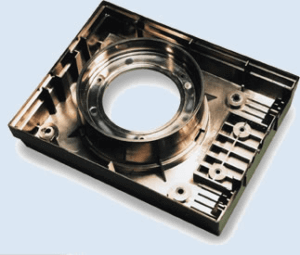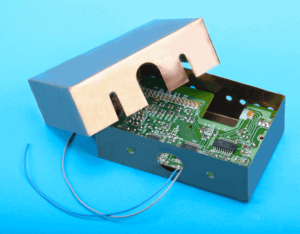JHSC Home / Products / Holland Shielding Home / How to Shield a Plastic Housing
How to Shield a Plastic Housing
Below we will explain in detail how a plastic housing can be EMI-shielded and which products you can use.
Electromagnetic fields travel through plastic electronics enclosures very easily. As a result, this type of housing is not electromagnetically compatible; in other words, electromagnetic fields generated by other equipment may interfere with the electronics, or fields emitted by the device may interfere with other electronics in the vicinity. In order to solve such problems, a shielding layer (EMI shield) will have to be applied to the plastic to make the device EMC-proof.
There are several ways to provide premium EMI/RFI shielding performance. A particular solution may be chosen depending on the attenuation desired. One option is painting the housing with a conductive spray, which will offer a relatively low reduction but has the advantage of being easy to apply to complex shapes. There are also films which result in higher reduction levels, but it can be difficult to apply them in housings with complex shapes.
When requesting advice, please provide answers to as many of these questions as possible.
In order to EMC-shield a plastic housing, the following solutions are available:

Electrically conductive nickel coating (Part nr. 3801), available in aerosols of 365 ml, tins of 5 liters and tins of 20 liters
More information about 3801 series Electrically conductive nickel coating

Electrically conductive metallization (Part nr. 3838), available on request. For a quotation please please send us a picture of your plastic enclosure with the amount needed
More information about Conductive metallization

EMI enclosures (Part nr. 1900). Mu-copper housings and enclosures for EMI shielding of PCBs inside a plastic housing
More information about EMI/RFI shielding enclosures

High-precision conductive EMI foil shaping
More information about High-precision conductive EMI foil shaping
If you would like to receive advice (free of charge), please send your drawing by e-mail to info@japanhomeland-security.jp .
Tip: Never use silicone anti-backing because that cannot be removed again. Release agents based on grease or oil are all right, because they can be removed in our cleaning/degreasing process. Your moulder should be notified of this beforehand.
In general:
When large quantities (more than 5000) are to be considered, metallization is usually a better solution. Since this is done in a vacuum, an appropriate jig is needed to hold the component and also to partially mask it (for example, to prevent short circuits). Jigs are manufactured in our machine engineering plant; they have to be designed and built with great precision and the process takes several weeks. With dimensions exceeding 500 mm the metallization process generally becomes more expensive; usually large items are sprayed with conductive paint.
When you need a product quickly, and the series is small (up to several hundred), we recommend using a conductive layer of paint (conductive coating) which we can apply for you, or you can apply it yourself if you have the equipment needed. When the geometry of the product is simple, it is possible to shield the device with a film or a textile product. This is also a good way to EMI-seal only the sensitive parts of your product. The tooling is relatively inexpensive because this type of shielding can be produced with a cutter guide or a laser-cut machine.
When parts are small (up to 100 mm) and high mechanical properties are not required, a conductive plastic may be used. It is best in this case to consult with your moulder and us in order to find the best possible solution.
With a galvanic or chemical treatment (for small parts and large quantities), generally speaking, a selective coating is not possible. Both the inside and the outside are treated.